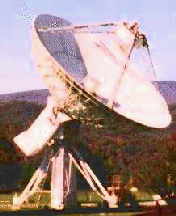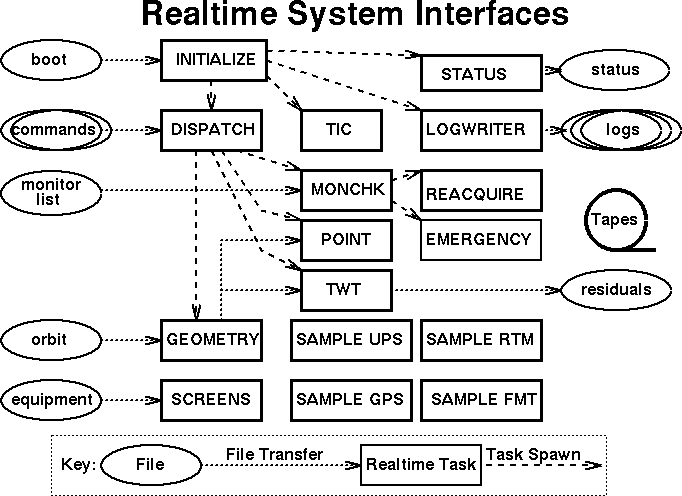 Station Real Time Software
Station Real Time Software
The station real time comtrol computer is a single MVME 147
computer running the VxWorks real-time operating system.
The computer configuration and programming style is similar to
that of the VLBA antenna control system.
Many of the software modules used for controlling the
VLBA antennas and hardware are used in the OVLBI system.

Initialization
The initialization function for the tracking station runs usually
only at system reboot. During reboot of the system, several critical
tasks are spawned and hardware reset functions are preformed:
- MCB RESET
- All Monitor Control Bus (MCB) devices are reset during
initialization.
- TIC
- Station timing task, TIC, generates semaphores to synronize
the real-time tasks.
- LOGWRITER
- All offline logs are writen by LOGWRITER task. All other realtime
tasks write to a message queue. This message queue is read by the
LOGWRITER task and written to files in 15 minute blocks.
- DISPATCH
- Task DISPATCH reads the default command file (start.cmd),
which sets all station hardware in the defualt state upon reboot.
- STATUS
- Task STATUS generates an ascii summary of the station state
for diagnostic purposes.
Realtime Tasks
A large number of tasks are spawned by INITIALIZE and by the
operator interface (SCREENS).
The realtime tasks are described below:
- DISPATCH
- The station control task, DISPATCH is spawned by initialized.
The DISPATCH task sets the station hardware into the
desired state, based on the command file inputs. The desired
station state read by the MONCHK task.
DISPATCH exits upon reaching the end of the input command file.
The station operators restart the DISPATCH task using the SCREEN
program.
- MONCHK
- System status is monitored by the MONCHK task. This
task periodically calls a set of "monchk functions" which query
the station hardware and software. Monitor data
are logged at pre-defined intervals.
The monitor data are compared with the desired state of the
station hardware. If hardware values fall outside
of predefined limits or are not equal to the desired state,
anomalies are raised and recorded in the station log.
The MONCHK task may spawn REACQUIRE and EMERGENCY in
response to unusual circumcstances.
- REACQUIRE
- If the satellite signal is lost for a signifcant time, the
satellite downlink signal must be reaquired and the formatter
clock reset. At the time of setting the formatter clock, the
decoder clock is read and the value recorded.
- EMERGENCY
- During high winds, power outages or other serious anomalous
conditions, an EMERGENCY task is spawned. This task notifies the
station operators and takes appropriate action.
- GEOMETRY
- The GEOMETRY task reads the orbit file and maintains
a circular buffer of orbit file entries. The orbit
file entries read into the system always bracket the current
time.
- POINT
- The antenna motion is controlled by the POINT task which
commands antenna motion. If satellite trajectories are followed,
the POINT task interpolates between entries from the orbit file.
If astronomical objects are followed, then the azimuth and elevation
of the source is followed based on calculations internal to POINT.
- TWT
- The Two-Way-Timing task uses the orbit file data maintained
by GEOMETRY to calculate parameters for the TWT module to
follow the uplink and downlink frequency predictions.
Once a second, the TWT task performs a cubic interpolation of the
orbit. The differences between the predicted and measured downlink
are recorded in a phase residual file. This file is written
directly to the station internal drive. After the pass, the
file is copied to the offline system and deleted from the internal
drive.
- SCREENS
- Many tasks are spawned, at low priority, to support the
operator interface package, called SCREENS.
Many SCREENS are typically used by the operator, and each SCREEN will
cause the SCREEN control program to spawn two tasks. One task
will take the asyncronous operator input, and the other task will
continuously display the hardware values on the terminal.
Many SCREENS (such as TAPE support) were taken unmodified
from the VLBA software.
- SAMPLE Tasks
- Some hardware devices respond too slowly or too un-reliably
to allow direct communication between device and time critical task.
Sample tasks, like SAMPLEGPS continually pole the hardware device
at some frequent rate. The values are saved and immediately returned
to any other TASK require the information.
- SAMPLE GPS
- The station absolute time is calibrated relative to
GPS measurements of the offset between station 1 Hz and GPS 1 Hz.
The True Time GPS module returns the GPS time of the station 1 Hz.
- SAMPLE UPS
- Some critical modules are kept on UPS power backup in order to
maintain station timing. The SAMPLEUPS task priodically
reads the UPS state, returning whether the station is on
UPS backup and if a power glitch has occured.
- SAMPLE RTM
- The Round Trip Measurement task measures the variation in the
fiber optical cable length between the maser source in the
Interferometer basement and the antenna vertex rack.
The module which measures the round trip time is located at the
Interferometer, and the SAMPLERTM task uses "RPC" calls to the
realtime computer called "sitetime", to retrieve the maser status.
- SAMPLE FMT
- The calibration tones are extracted from the downlink data
by the VLBA formatter module. The tone extraction must be timed
relative to the satellite 1 Hz pulse, and this timing is performed
by the SAMPLEFMT task. The calibration tone data are
used by the CALTONES SCREEN and raw calibration tone counts
are logged.
The realtime control task, DISPATCH, sets the station state
based on input command files. These command files
are ascii files that are readable (and editable).
The top level files are generated by the offline program,
SCHEDCO.
The top level command file "includes" several lower level
command files that setup all station hardware.
Numerous command files have been written to set the hardware
in special test modes.
Command files are also used to place the system in a mode
for making pointing observations of astronomcical raio sources.
The orbit files are simple ascii tables
time tagged by date and time. The GEOMETRY task reads the
orbit prediction data and makes it available to the POINT and
TWT tasks.
The operator interface to the tracking station control computer is
the same as that for the VLBA, the SCREEN package. Little
design documentation is available for the package, but since
the GBES version has a different layout that the VLBA version,
a GBES SCREENs
users guide is available.
Return to the Station Software Guide.
The National Radio Astronomy Observatory
(NRAO)
is a facillity of the
National Science Foundation
operated under cooperative agreement by
Associated Universities, Inc.
glangsto@nrao.edu Last update: 97 July 1
 Station Real Time Software
Station Real Time Software Station Real Time Software
Station Real Time Software